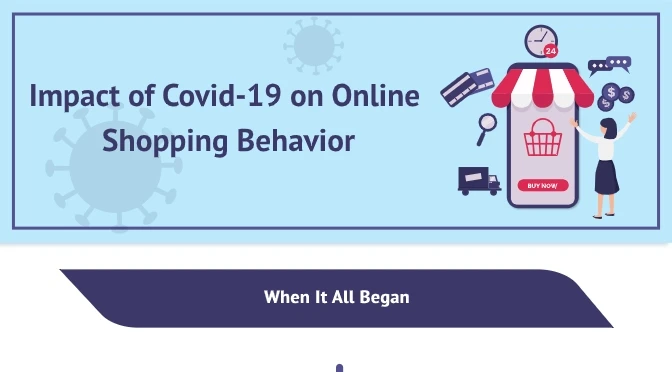Infographic: Impact Of COVID-19 On Online Shopping Behavior

The COVID-19 pandemic has changed almost everything. It has changed every aspect of our life. It has brought about changes around the world that we never thought were possible. We have changed things from how we work to how we communicate but one of the most noteworthy changes has been in our shopping behaviors.
These changes in all aspects of our lives have called upon all businesses to change the ways in which they operate because people have changed their buying behaviors.
One of the primary reasons why businesses have to quickly adapt to this scenario is that customers have been forced to choose between what they consider essential and what they consider non-essential items. Consumers have changed their buying behaviors as a reaction to the ongoing pandemic.
 Embed this infographic on your site
Embed this infographic on your site
In this post, we’ll discover how exactly the changes have affected the buying behavior, whose buying behavior has been affected, and what might be the future trends that we can expect to see.
When it all began
There have been many speculations as to when the first case of COVID-19 came about but WHO has claimed that the first case of pneumonia of unknown cause was detected on December 31, 2019, by the WHO country office in China.
The virus spread at an alarming rate and on March 11, 2020, the World Health Organization (WHO) declared that the COVID-19 outbreak was no longer an epidemic, but a pandemic. This was the time when governments and businesses around the world started taking extreme measures to control the spread of the virus.
These extreme measures such as enforcing lockdowns have had a tremendous impact on not just the businesses but also the psychology of the people.
What has changed
- Lifestyles have changed as social distancing has become the new norm
One of the most effective ways to decrease the spread of the infection is to maintain a safe distance amongst ourselves. People have become more cautious and have started spending more time with themselves.
- Home is the new cubicle as work from home takes over
Ever since the world shut down, corporations and businesses have been adopting new ways to work and collaborate. One of the most prominent ways of working is Working-from-home.
This has been a hot topic of debate amongst the working class as they try to maneuver through these tough times and find new ways of managing employees as micromanaging is now not an option. Homes have become the new cubicles for everyone.
- People are adopting a healthy lifestyle
85% of consumers have said that they have adopted some kind of physical exercise during these times. While 40% of these have said that they would continue with these habits even after the restrictions were lifted.
This change in lifestyle has translated into an enormous amount of sales in the sector and also lots of social media content is being generated around the same lifestyle changes.
- Shopping preferences and behaviors have seen a drastic change
With a need to feel in control of the situation, people are buying almost every essential item that they can get their hands on. In this time of a pandemic, it makes them feel prepared.
This fear has caused steep changes in their preferences and buying behaviors because they have been forced to think about what is essential to them and what is not.
- People are spending on average 10-30% more online
While it was believed that the current environment would slow down the sales of retail businesses, it’s effect has been quite the opposite. The Ecommerce retail business was poised to generate a revenue of $6.5 trillion by 2023, but seeing the current upsurge in sales it is already working on maximum capacity with people spending 10-30% more than their usual purchase.

Who’s buying?
- Gen Z and Millenials
Overall, 96% of Millenials and 94% of Gen Zs have concerns around the pandemic and the effect it is going to have on our economy. Their buying behavior has shown that they are stocking up more on essential items.
This concern is pretty evident in the fact that their buying behavior has deviated the most. Their shopping preferences have changed as they’re spending their money less on luxuries and experiences and more on essentials and stocking up grocery supplies.
- Gen X and Boomers
24% of Baby Boomers and 34% of Gen X have admitted that the pandemic has forced them to change their buying behaviors but not as much as millennials, which is close to 50%.
In an overall trend, the younger generations have changed their buying behavior and preferences more drastically than the older generations.
- Men and Women
COVID-19 has women more concerned about the situation while men have reacted by considerably changed their buying behavior.
More men than women have admitted that the current situation around the pandemic has caused them to spend more differently.
Men have been avoiding going into stores and buying things at higher rates than women. While for both of them, online shopping has become the primary source of buying.
There has been a mixed trend in the growth of the eCommerce sector. While some categories have flourished exponentially, others have not done quite that well. Going further, we will discuss the top 10 increases and decreases in the eCommerce product categories in March 2020 as compared with March 2019.
Which categories are going up
- Disposable Gloves: 670%
- Bread Machines: 652%
- Cough & Cold: 535%
- Soups: 397%
- Dried Grains & Rice: 386%
- Packaged Foods: 377%
- Fruit Cups: 326%
- Weight Training: 307%
- Milk & Cream: 279%
- Dishwashing Supplies: 275%
Which categories are going down
- Luggage & Suitcases: -77%
- Briefcases: -77%
- Cameras: -64%
- Men’s Swimwear: -64%
- Bridal Clothing: -63%
- Men’s Formal Wear: -62%
- Women’s Swimwear: -59%
- Rash Guards: -59%
- Boy’s Athletic Shoes: -59%
- Gym Bags: -57%

What’s the new normal?
Many experts have predicted that these shopping trends are here to stay, while the others are saying that this is just a short term change in consumer behavior and this is bound to go back to normal as the pandemic begins to come under control.
Amazon has admitted that they do not have enough stock to keep up with the astronomically high demand. Many new stores have started delivery in the wake of this pandemic.
The timeline is certainly short to predict what is going to happen in the future but we can say some things for sure. Ecommerce brands need to prepare themselves better for such occasions and many brands need to rethink their business model or at least consider expanding into new territories.


